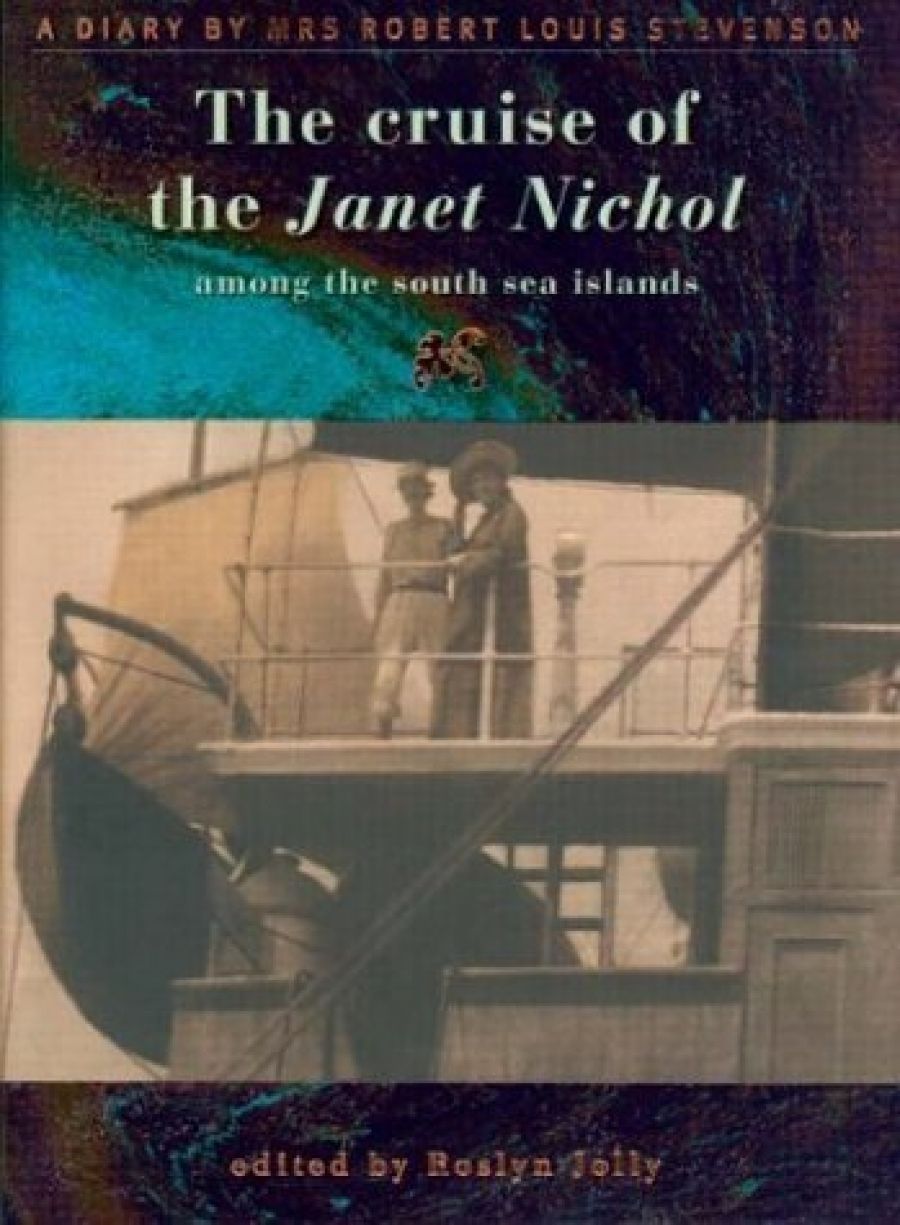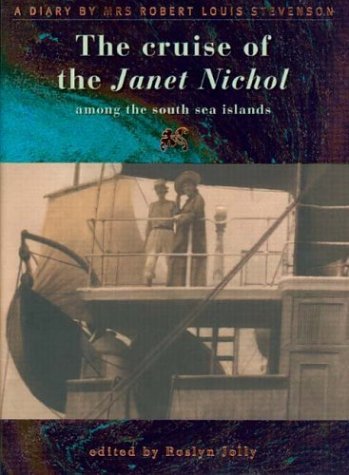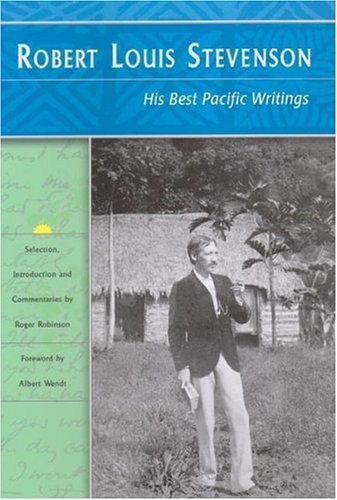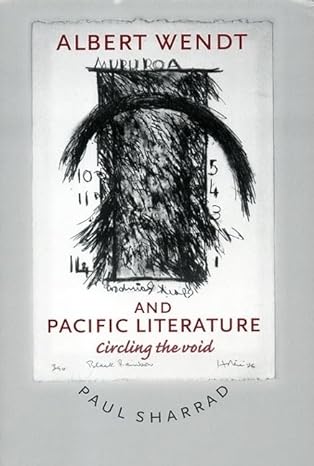
- Free Article: No
- Contents Category: Travel
- Review Article: Yes
- Article Title: Looking at Both Sides
- Online Only: No
- Custom Highlight Text:
Whether it’s fate or mere coincidence, the life stories of the two most celebrated writers of the Pacific – Robert Louis Stevenson and Albert Wendt – dovetail together on the small tropical island of Upolu in Western Samoa. In 1889, when Stevenson concluded his third Pacific cruise on the Janet Nichol, he told his readers in Europe and America that: ‘Few men who come to the islands leave them; they grow grey where they alighted; the palm trees and trade-wind fan them till they die.’ In hindsight, this reads as a premonition, but, after years of ill-health Stevenson was seduced and invigorated by sweet air and unexpected interests, describing his time during the Pacific voyages as ‘passing like days in fairyland’.
- Book 1 Title: The Cruise of the Janet Nichol among the South Sea Islands
- Book 1 Subtitle: A diary by Mrs Robert Louis Stevenson
- Book 1 Biblio: UNSW Press, $34.95 hb, 208 pp
- Book 1 Cover Small (400 x 600):

- Book 1 Cover (800 x 1200):

- Book 2 Title: Robert Louis Stevenson
- Book 2 Subtitle: His best Pacific writings
- Book 2 Biblio: UQP, $35 pb, 320 pp
- Book 2 Cover Small (400 x 600):

- Book 2 Cover (800 x 1200):

- Book 3 Title: Albert Wendt and Pacific Literature
- Book 3 Subtitle: Circling the void
- Book 3 Biblio: Auckland University Press, $49.95 pb, 312 pp
- Book 3 Cover Small (400 x 600):

- Book 3 Cover (800 x 1200):

With his beloved and free-spirited wife, Fanny, Stevenson sought a new life far removed from the literary celebrity he attracted in Edinburgh or New York. Purchasing the Vailima estate on Upolu, they built a gracious colonial residence and intended to become self-sufficient from the produce of the farm. But by December 1894 Stevenson, aged just forty-four, was dead from a cerebral haemorrhage. His body was laid out upon a Union Jack and wrapped in ceremonial Samoan mats. A procession of Samoan chiefs carried it to a grave on the summit of an island peak, overlooking the sea.
Roger Robinson’s new anthology of Stevenson’s Pacific writings opens, appropriately enough, with a foreword by Albert Wendt. Born in Apia in 1939, Wendt traces his early connections to the ‘Writer of Tales’: ‘Robert Louis Stevenson has been a presence in my life ever since I was born. From our family home in the Vaipe, Apia, you can always see Mount Vaea and its summit where Stevenson is buried … So, daily, when we got up and gazed at Mount Vaea, we “saw” Stevenson and the legend of Tusitala.’ For Wendt’s generation, growing up in the last decades of the New Zealand administration, rote-learning Stevenson’s poem ‘Requiem’ (‘Under the wide and starry sky / Dig the grave and let me lie … ‘) was a requirement at school. Local legend told of a sickly Scottish writer who arrived, won the friendship of the Samoan people, and then died.
In those few years, Stevenson’s literary output had created within the European–American imagination a new consciousness of the colonial Pacific and its indigenous and European inhabitants. The market was eager for more works from the celebrity author of Treasure Island, Kidnapped and Jekyll and Hyde. Once he hit the Pacific, Stevenson continued to be remarkably prolific. Robinson has gathered together exemplars of Stevenson’s fictions of romance and adventure, poems, letters, a speech of gratitude to Samoan chiefs, prayers and travel memoirs. Much of this material is now difficult to locate, and Robinson’s commentaries helpfully position each piece, as well as providing a loose bridging narrative of biographical and historical information.
Is this anthology, as it boldly claims, the ‘best’ of Stevenson’s Pacific writing? Well, I’m not going to quibble, because this is a terrific collection, with much to savour and discover. Robinson’s selection does what good anthologies should do: leave the reader eager to seek even ‘better’ by turning to the original texts. There is always a vitality in Stevenson’s prose, but his encounters in the Pacific led him to experiment with innovations in style, to seek a new language to convey the foreigness of subjects and events. As Robinson points out, Stevenson had no interest in ‘swashbuckling his way around an enchanting South Seas of Western fantasy’. His observations of Pacific cultures take the pervasiveness of the super-natural or the ritual of cannibalism seriously, asking readers to suspend judgment by ‘looking at both sides’. They also document the physical destruction and psychological trauma of societies radically destabilised by European colonialism, and the dynamics of power as these evolved through the interactions between European and Pacific cultures.
Stevenson’s views of colonialism were, like his views on most things, far from conventional. His Pacific stories, like earlier work, focus on the human condition in all its ambiguities and contradictions. In ‘The Beach of Falesá’ (reproduced in full with original illustrations), the romance between the white trader Wiltshire and his Polynesian wife Uma unfolds amid a gamut of racial, sexual and economic tensions. In excerpts from the extraordinary A Footnote to History, the political intrigues and anti-colonial struggles of the Samoan people are recounted sympathetically, and the absolute right of European ideas challenged. For Wendt, this remains Stevenson’s most ‘relevant’ work, because of its commitment to Samoan independence. And as Robinson perceptively suggests, the Footnote’s skilful blending of ‘contemporary history’ and reportage signals a ‘landmark in modern journalism’; a precursor to the documentary essays of the New Yorker or Granta.
Another recent bonus for fans of Stevenson, travel writing and Pacific literature more generally is the reissue (for the first time since 1914) of Fanny Stevenson’s Cruise of the Janet Nichol, edited and admirably introduced by Roslyn Jolly. This new edition is handsomely designed, printed on pale buttery-coloured paper, and includes numerous photographs of the people and places mentioned in the diary entries.
In April 1890 the Stevensons, accompanied by Fanny’s adult son, Lloyd Osbourne, departed from Sydney on their third Pacific voyage. The Janet Nichol was a trading steamer collecting copra and shell, and taking home groups of islanders who had been caught up in the notorious labour or ‘blackbirding’ trade. As passengers, the Stevensons were along for the ride and had no say in an itinerary that took in about thirty-five islands in the central and western Pacific. At some of these, such as Apemama and Mariki in the Gilberts, they were reacquainted with old friends. But much of the island-hopping took them to new territory, from the independent kingdom of Niue to places in what were then known as the Cook, Tokelau, Ellice and Marshall groups.
Fanny was no nervous Victorian lady. Following her controversial marriage to Stevenson in 1880 (she was American, divorced and eleven years his senior), they had honeymooned in an abandoned Californian silver mine and lived in places as varied as Scotland, the south of France, Bournemouth and the primitive Adirondacks in upstate New York, before heading into the Pacific. Fanny thrived amid the practical difficulties aboard ship or setting up house at Vailima, and was as eager as her husband for cross-cultural encounters. The diary reveals her to be contrary, self-centred and bossy, but also resourceful and generous. Fanny’s bohemian approach was further liberated by age (she was fifty). She chose to sleep on the open deck with the male passengers, and ventured unescorted on the islands. She wore loose dresses, no shoes, and liked to borrow clothing from islander women. When the Stevensons disembarked at Noumea after four months at sea, Fanny wrote: ‘We all don the clothes of civilization to go on shore, looking very strange to each other.’
The Janet Nichol diary was initially intended to be ‘a collection of hints to help my husband’s memory’, and there was a degree of collaboration in the Stevensons’ published work. But Fanny had her own literary particularities and interests, and her observations of European missionaries, traders, and beachcombers are sharp and often funny. She obviously delighted in the extended exchanges of goods that occurred each time the travellers alighted, and was a determined collector of Pacific objects. Most importantly, she was curious about the lives of the women she met in their island homes. Fanny spent time with stately queens, old women and young girls, and the occasional white missionary wife. Her descriptions of domestic relations and practices (food, sleeping arrangements and so on), and her pen portraits of individual personalities provide a unique historical record of women’s particular experiences within Pacific societies in flux.
Paul Sharrad’s comprehensive study of Albert Wendt is restorative in intention. As the first – and long overdue – book-length examination of Wendt’s writing, Sharrad aims to ‘rectify’ (despite numerous international prizes) the general lack of attention given to Wendt’s substantial oeuvre, especially in comparison to work by other post-colonial authors from Africa, the Caribbean and India. In doing so, he provides a context for understanding how Wendt’s literary vision has been shaped by the particularities of both Samoan and wider Pacific cultural identities. While much of Wendt’s writing is mythological, it is firmly rooted in the overlapping histories of pre-colonial life, colonialism, decolonisation and modernity within the Pacific. Family dramas unfold within a world where the circle of tradition has been shattered, and the ‘void’ must be reclaimed.
Wendt has had a distinguished career as the author of poetry, fiction and essays; a teacher and academic; and a prominent commentator on issues of indigenous self-determination and social justice. Written primarily as a scholarly text for students of literature, Sharrad’s study divides Wendt’s career into three chronological sections spanning the 1970s to the 1990s, and further portions these into chapters offering close readings of key texts. Wendt’s literary career was launched with his bestselling Sons for the Return Home (1973), which reflected autobiographical experiences as a migrant in New Zealand, and was a radical text in its exploration of cross-cultural sexuality and displacement. His more recent work shows a break from this realist mode, and experimentation with literary forms ranging from ironic self-critique to the cinematic elements of Black Rainbow (1992). Sharrad assuredly surveys these stylistic shifts, summarises plots, and synthesises criticism. This informed literary commentary is complete with an extensive bibliography of Wendt’s extensive writings, and of those about him. It is perhaps a missed opportunity that its publication date precludes discussion of Wendt’s latest novel, The Mango’s Kiss (2003), a sprawling Samoan saga sixteen years in the making.
Sharrad is a champion not only of Wendt but of Pacific literature as a whole. When Stevenson decided to remain in Samoa, he was aware that ‘I must learn to address readers from the uttermost parts of the sea’. But he and Fanny wrote, like other European sojourners, about the Pacific. It has been because of Wendt and other Pacific writers that, thankfully, we can now read their cultures from within.


Comments powered by CComment